Pop quiz. What is this: 
A) An emoji crying tears of joy.
B) A picture that’s worth 1,000 words.
C) An Oxford Dictionary word of the year.
Answer: All of the above.
Emojis have been around since the late 90s when they first showed up on Japanese phones. Fast forward to the 21st century. The White House uses them in their reports. Tim Hortons expresses their proud Canadian-ness with them. Domino’s lets you place an order via pizza slice.

There are multiple emoji guides and even the Unicode Emoji Subcommittee, which has a very professional-looking web page.
Here’s why people, including businesses and their audiences, love emojis:
- Emojis are available on our smartphones and favorite social media platforms now. They’re always at our fingertips.
- People can quickly express their emotions even if they don’t have the time to write out the sentiment. It’s also a nice alternative for those who feel they can’t express themselves accurately through words.
- Customers dictate how they want to be communicated with. For some brands, opting to use emojis is the same as offering live chat or Twitter support – it’s about discovering what your audience wants and giving it to them.
- Brands that use emojis can increase engagement rate.
A Brief History of Emoji Marketing Wins and Fails
These guys got it right:
Deadpool: Audiences loved this. Celebrities loved this. The press loved this. Thumb’s up emoji, guys.

Source: Social Seeder
(The marketing for Deadpool was genius across-the-board, so check out the other stuff they did to woo audiences.)
Word Wildlife Fund: The WWF made 17 emojis of endangered animals and donated money every time one of them was re-Tweeted. It did the trick.
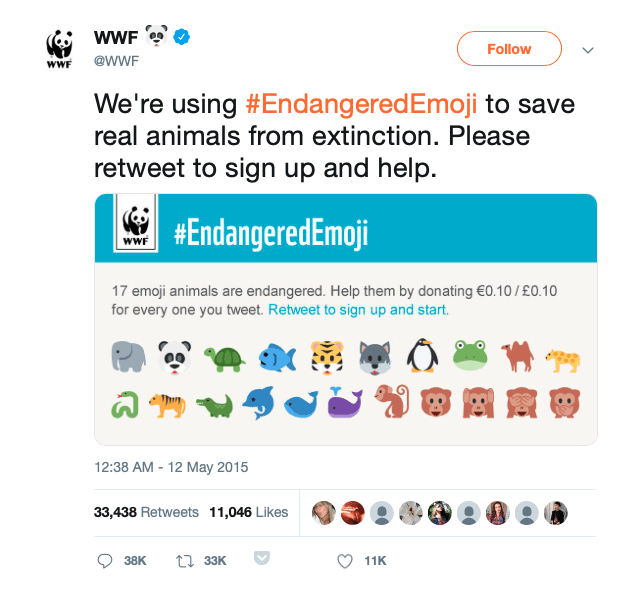
Taco Bell: Taco Bell went hard for the taco emoji. The Unicode Consortium says it wasn’t the taco emoji petition that sealed the deal, but I don’t totally believe them. Regardless, Taco Bell got a ton of attention with this campaign, and I’m guessing they sold a few more tacos than normal.
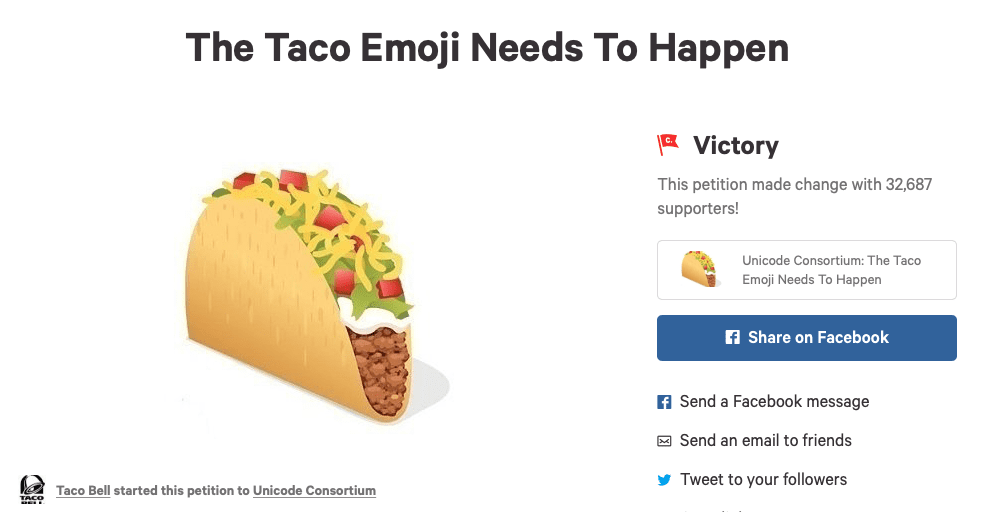
Source: Change.org
These guys are doing the face palm emoji right now:
Juicy Fruit: Nobody knows what you’re trying to say, Juicy Fruit. Why is there a guitar? Why is there a guitar???
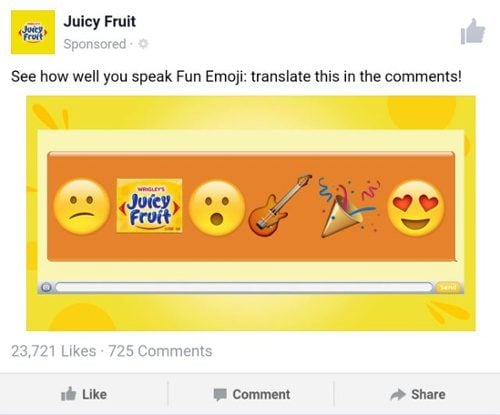
Source: Washington Post
OMG Shakespeare: Maybe it’s the English major in me that makes me cringe, but these seem ridiculous and critics agreed. They snagged some decent feedback on Amazon, but YOLO Juliet was the most-reviewed one and only had 63 reviews, so…not great. Also, I think that saying “YOLO” to Juliet is kind of missing the point.
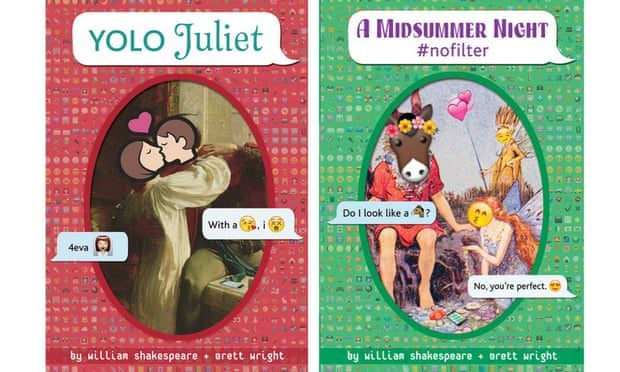
Source: The Guardian
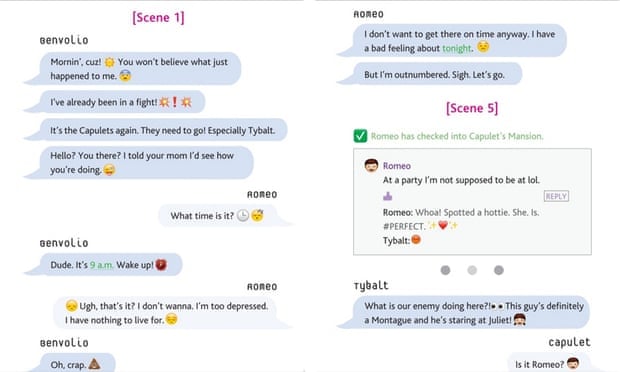
Source: The Guardian
Chevrolet: Just…why?!?!
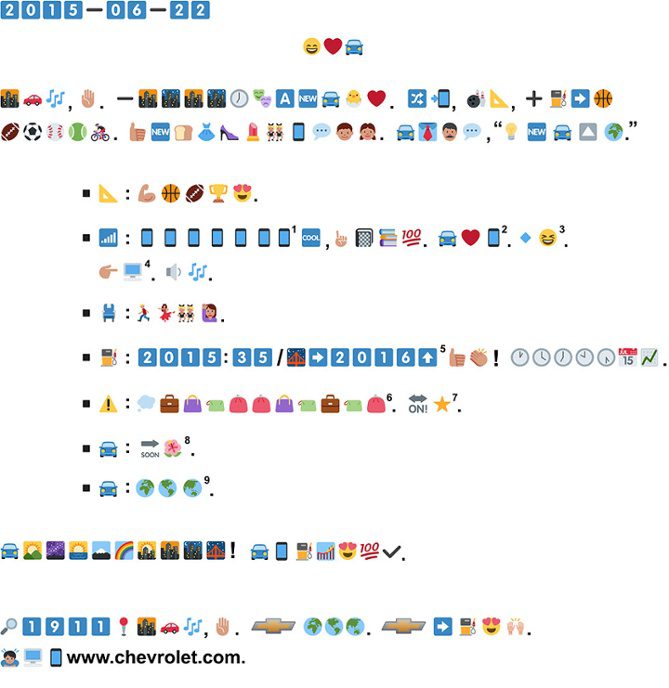
Source: Chevrolet
Are Emojis Right for Your Brand?
- Are you only interested in emojis because other brands are using them? Being influenced or inspired by other brands is one thing; betraying your personal brand voice just to follow the lead is another. No brand has ever been successful by doing what all the other ones are doing – you have to stand out from the crowd and give customers something different.
- Does it feel on-brand and/or natural? If you don’t even feel natural using emojis in your marketing, your audience is going to notice. Emojis aren’t a good fit for every brand – don’t force it.
- Is your audience fluent in emoji? Consider demographics so you don’t alienate your audience. Millennials between 18 and 34 use visual expressions, including emojis, more than 2x as much as people over 65. About 25% of people in the age groups between those categories feel that images can communicate better than words.
- Is your audience already using emojis? Hopefully you’re using tools to track what your audience is saying about you online. As you scroll through the commentary, do you notice that people are using emojis? That’s a good sign that you should follow suit.
Bottom Line: You always have to resonate with your audience. If emojis do that, excellent. If they don’t, leave them out.
How to Use Emojis for Business
Decide When and Where You’ll Use Emojis
Create your own emoji guide – you can add emojis to your marketing without adding them everywhere. Maybe you want to use them just in live chat or on Instagram. Maybe you want to use them just once in a while instead of making them a regular part of your marketing, like how Bud Light created an emoji flag to celebrate the Fourth of July. The only exception here is with email, which I’ll get to in a sec.

Know What That Emoji Means
Remember all those people who posted “Netflix and chill” without realizing they were referring to…you know. Don’t be like those people. Before you emoji, educate yourself.
Make it Obvious
Just like you don’t want to misinterpret an emoji’s meaning, you don’t want your audience to misinterpret your meaning, either. Make sure that your intention is clear and that you communicate what you mean to.
Relate to Customers
Emojis can be helpful in customer support if you use ones that accurately represent emotions, like a surprised face to say “Oh no!” when the customer is facing a frustrating issue. Don’t replace full sentences with emojis, just use them to add context.
Test it Out
Updating your marketing to incorporate emojis is a good exercise in changing with the trends. The more you evolve your techniques with the current culture, the easier it will become to make changes as needed. Not everything is going to stick, so do a trial period. World Emoji Day, July 17th, is a good opportunity to test the emoji waters to see how your audience responds.
Get Your Audience Involved
Ask your audience to use emojis in order to describe something. Taco Bell encouraged their audience to use emojis with this Tweet:

You can also post a question or statement on social media and ask your audience to reply with an emoji, like a smiley face or a sad face, or challenge your audience to decode an emoji message.
Carefully Consider Emojis in Emails
Be extra careful when using emojis in email marketing. If you’re sending a newsletter to your VIP customers who are already familiar with your brand voice and how often you use emojis, go for it. Otherwise, you could hurt open rates by using an emoji in your subject line. Also, don’t ever use emojis in email if you’re not using them elsewhere, too.
Using Existing Emojis vs. Creating New Ones
Using existing emojis couldn’t be easier. They’re already available and you can reference an emoji guide to see exactly what they mean, so you just have to incorporate them into your messaging however you decide to. When choosing which emojis to use, consider these questions:
- Which emojis are your audience members already using?
- What are the emojis that seem to carry the most interest or meaning for them?
- How can you apply that meaning to your brand or extend it to appeal to your customers even more? Sephora does this well on Twitter.
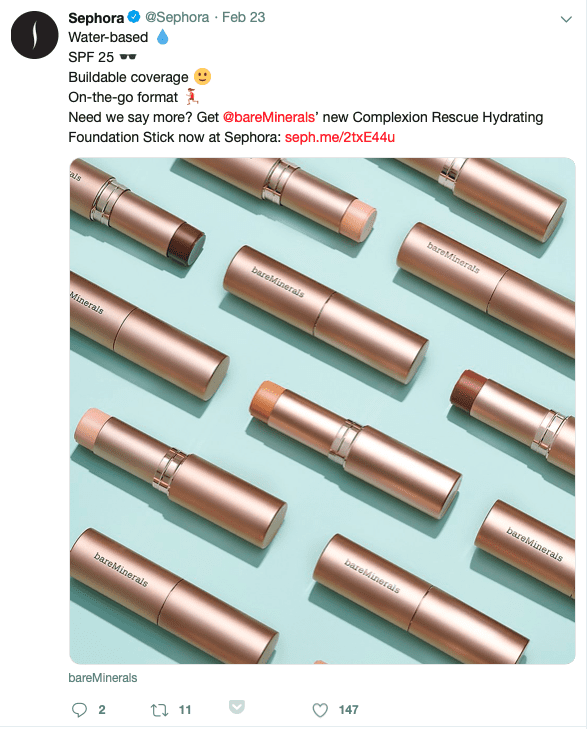
The Case for Creating Your Own Emojis
Yes, using existing emojis can help with communication, immerse your brand in the current culture and help you relate to young audiences. However, they’re not going to be impactful for your overall branding – your audience won’t necessarily think about you when they use an emoji in a different context.
If you want to use emojis as a branding tool, you may have to create your own. Tick one or more of these boxes when designing branded emojis:
- Add to the conversation in a more convenient or impactful way than words can express.
- Enhance the customer experience.
- Delight or surprise your customers, or strike another emotional chord.
- Fill a need. For example, Dove created a Love Your Curls emoji keyboard to represent women with curly hair, a group that didn’t yet have their own emoji.
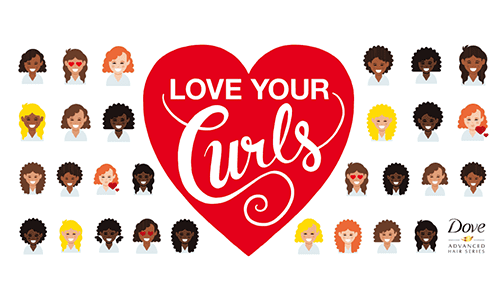
Source: The Shorty Awards
4 Tips for Creating Your Own Emojis
- Branded emojis require your audience to download and set up a separate keyboard. This is an extra step (or two or three) that consumers have to take. They need (a) awareness that the keyboard exists, (b) guidance on how to do it and (c) enough of a reason to go through with it. You may want to create a contest for people who use your new emojis.
- You want your emojis to become synonymous with your brand, but you don’t want to over-brand, which can keep your customers from actually using them. Customers should be able to use your emojis in their normal conversations.
- Create a collection of emojis instead of a one-off emoji. A singular emoji is forgettable and looks like your company didn’t try very hard.
- The emojis in your collection should represent different things – if you’re a cafe, you don’t necessarily need 3 different cups of coffee. Think of the products and themes you want to represent, as well as the different audience segments you want to appeal to, then design one emoji for each.
A Note About Stats
The jury’s still out on whether or not emojis increase brand engagement – there are articles that refer to increased brand engagement but don’t include any stats, there are a few articles that do have convincing stats and then there are articles that say that emojis don’t increase brand engagement at all.
Those negative stats are a little misleading, though. One study reports that 5% of responders said they wouldn’t be more likely to buy from a brand that uses emojis in their digital marketing. But brands aren’t necessarily using emojis as a precursor to getting a sale. Sure, sales are always the ultimate goal, but the touchpoint where the emoji comes in separate from the sales conversion.
Emojis are used in the branding stage where the company is creating and showcasing their voice; in messaging with current customers who already have and will again buy; or in marketing campaigns that spread brand awareness. Plus, consumers don’t always realize how much branding will impact their future purchase decisions.
Bottom Line: The stats and studies you have to worry about are your own.
Emojis have their time and place, and powerful brands know when and when not to use them. Whether or not you add emojis to your marketing, keep track of their impact on culture. Staying in-the-know will give you insight into your audience and inform your brand of when to jump in and get involved.
Ready to create a marketing strategy? We got you.
The post An Emoji Guide for Marketers: Using Emoji Professionally appeared first on Elegant Themes Blog.
